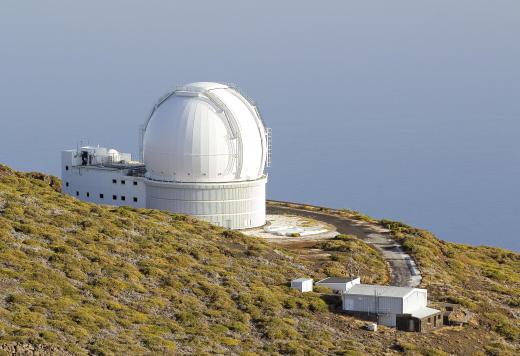What is the Overwhelmingly Large Telescope?
 Michael Anissimov
Michael Anissimov
The Overwhelmingly Large Telescope (OWL) is a concept design by the European Southern Observatory (ESO) to create a $1.2 billion USD telescope with a 100 meter (328 ft) lens, which would the largest optical telescope ever built. The scale has since been decreased to a 60 meter (200 ft) lens. The target date for completion is around 2019, and the plains east of Antofagasta, Chile are being considered for the site, due to its year-round clear skies and high altitude.
If completed, OWL would be able to observe objects 1000 times fainter than the Hubble Space Telescope. Although some interferometry projects will have a greater angular resolution than OWL, it will have greater light-gathering and imaging capacity, allowing for sharper pictures of faint and distant astronomical objects.

Because there is no technology in existence to make a 60 meter lens, any lens for this purpose would have to be segmented. To get an idea of why it is called the Overwhelmingly Large Telescope, imagine a mirror with a diameter the size of a 20-story building. Due to its huge size, cost, and complexity, it is no surprise that a feasibility review board for the ESO decided that OWL should be put on the back burner of their priority list.
Although OWL may still see the light of day, for the most part the ESO is currently focusing on the European Extremely Large Telescope, a scaled-down telescope with a 40 meter lens, for a cost of approximately $800 million US Dollars (USD). This would still be precise enough to resolve the atmospheres of extrasolar planets, which would let us do spectroscopic analysis to determine the possible presence of organic compounds.
Using a technique called adaptive optics, which was developed to reduce atmospheric twinkling, OWL or something like it will surpass the space observatories as the world's greatest windows to space. Because it is so expensive to launch payloads into space, and comparatively cheaper to build a very large telescope on Earth, it is likely that the latter will dominate astronomy until launch costs can be brought way down.
AS FEATURED ON:
AS FEATURED ON:











Discussion Comments
My grandfather gave me a telescope when I was a young girl, and it wasn't a simple toy telescope. It was a real telescope. I can't possibly remember how many hours I pointed the instrument at the sky and tried to learn as much as I could about the things around me. A telescope is a great way to get a child's imagination running at full speed.
This is why I bought my children telescopes. By the way, telescopes are also good for spying on your neighbors, but I don't encourage my children to do this.
@Drentel - I know the money countries spend trying to learn more about what lies beyond our world is a lot, but in the long run we might find out that this is money well spent. What is going to happen when we eventually wear out the earth or blow it up?
Maybe if we continue with space exploration then we can find other worlds where humans can live when we can no longer live here.
And even if this scenario never happens, I think it would be really cool to have a large telescope so big and powerful that we could see places and objects so far away.
With all of the economic problems in the world today, why would any sensible organization want to spend the amount of money needed to build this overwhelmingly large telescope? I can appreciate space and the stars and planets as much as anyone, but not to the point of spending $800 million or $1.2 billion.
Even the United States has finally got the message about spending too much money looking into space. The country has all but abandoned its deep space program for the time being because the return hasn't been worth the investment. When the U.S. stops spending money, everyone should take the hint.
Post your comments